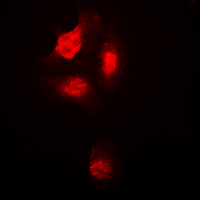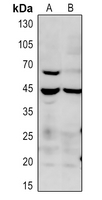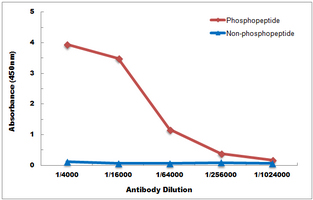Description:Rabbit polyclonal antibody to p38 (Phospho-T180)Immunogen:KLH-conjugated synthetic phosphopeptide corresponding to residues surrounding T180 of human p38 protein. The exact sequence is proprietary.Purification:The antibody was purified by immunogen affinity chromatography.Clonality:PolyclonalForm:Liquid in 0.42% Potassium phosphate, 0.87% Sodium chloride, pH 7.3, 30% glycerol, and 0.01% sodium azide.Dilution:WB (1/500 - 1/1000), IF/IC (1/50 - 1/200)Gene Symbol:MAPK14Alternative Names:CSBP; CSBP1; CSBP2; CSPB1; MXI2; SAPK2A; Mitogen-activated protein kinase 14; MAP kinase 14; MAPK 14; Cytokine suppressive anti-inflammatory drug-binding protein; CSAID-binding protein; CSBP; MAP kinase MXI2; MAX-interacting protein 2; Mitogen-activated protein kinase p38 alpha; MAP kinase p38 alpha; Stress-activated protein kinase 2a; SAPK2a
Entrez Gene (Human):
1432;
Entrez Gene (Mouse):
26416;
SwissProt (Human):
Q16539;
SwissProt (Mouse):
P47811;
SwissProt (Rat):
P70618;
Storage/Stability:Shipped at 4°C. Upon delivery aliquot and store at -20°C for one year. Avoid freeze/thaw cycles.
-
 Western blot analysis of p38 (Phospho-T180) expression in zebrafish (A) whole cell lysates. (Predicted band size: 41 kD; Observed band size: 43 kD)
Western blot analysis of p38 (Phospho-T180) expression in zebrafish (A) whole cell lysates. (Predicted band size: 41 kD; Observed band size: 43 kD) -
 Immunofluorescent analysis of p38 (Phospho-T180) staining in HepG2 cells. Formalin-fixed cells were permeabilized with 0.1% Triton X-100 in TBS for 5-10 minutes and blocked with 3% BSA-PBS for 30 minutes at room temperature. Cells were probed with the primary antibody in 3% BSA-PBS and incubated overnight at 4 °C in a humidified chamber. Cells were washed with PBST and incubated with a DyLight 594-conjugated secondary antibody (red) in PBS at room temperature in the dark.
Immunofluorescent analysis of p38 (Phospho-T180) staining in HepG2 cells. Formalin-fixed cells were permeabilized with 0.1% Triton X-100 in TBS for 5-10 minutes and blocked with 3% BSA-PBS for 30 minutes at room temperature. Cells were probed with the primary antibody in 3% BSA-PBS and incubated overnight at 4 °C in a humidified chamber. Cells were washed with PBST and incubated with a DyLight 594-conjugated secondary antibody (red) in PBS at room temperature in the dark. -
 Western blot analysis of p38 (Phospho-T180) expression in mouse liver (A), rat liver (B) whole cell lysates.
Western blot analysis of p38 (Phospho-T180) expression in mouse liver (A), rat liver (B) whole cell lysates. -
 Direct ELISA antibody dose-response curve using Anti-p38 (Phospho-T180) Antibody. Antigen (Phosphopeptide and non-phosphopeptide) concentration is 5 ug/ml. Goat Anti-Rabbit IgG (H&L) - HRP was used as the secondary antibody, and signal was developed by TMB substrate.
Direct ELISA antibody dose-response curve using Anti-p38 (Phospho-T180) Antibody. Antigen (Phosphopeptide and non-phosphopeptide) concentration is 5 ug/ml. Goat Anti-Rabbit IgG (H&L) - HRP was used as the secondary antibody, and signal was developed by TMB substrate.


 Datasheet
Datasheet MSDS
MSDS